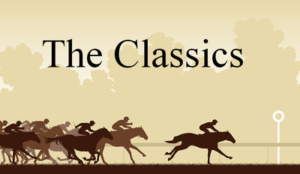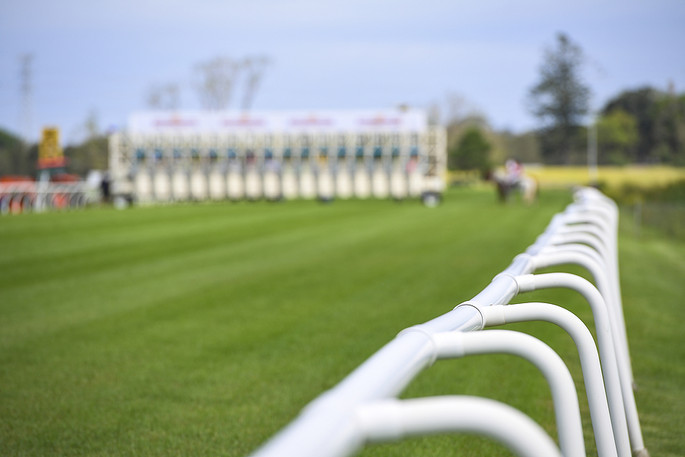 Horse racing is essentially split into two codes, with jump racing on one side and flat racing on the other. Whilst there have been some crossovers over the years, with the likes of Red Rum and Tiger Roll actually training as flat racing horses before going on to etch their names into the record books in the Grand National, the two sides of the industry tend not to come into contact all that often.
Horse racing is essentially split into two codes, with jump racing on one side and flat racing on the other. Whilst there have been some crossovers over the years, with the likes of Red Rum and Tiger Roll actually training as flat racing horses before going on to etch their names into the record books in the Grand National, the two sides of the industry tend not to come into contact all that often.
If you asked a non-horse racing lover to name a horse race then the chances are that the likes of the Gold Cup, the aforementioned Grand National and the King George VI Chase would get a mention, all of which are National Hunt events. It’s possible that a race such as the 2,000 Guineas or the Epsom Derby might get a mention, but not as likely. The Classics aren’t as loved by the general public as jump racing, but they’re no less respected.
Has a Racehorse Won All Five Classics?
No. To date, no horse has been able to win all 5 British Classic horse races. Formosa in 1868 and Sceptre in 1902 won four Classics though Formosa dead-heated in the 2000 Guineas. There have been 23 three-time classic winners, the last of which was Oh So Sharp in 1985.
What Are The Classics?

Let’s start by having a look at the five Classic events of British flat racing. They are as follows:
The British Classic Horse Races
| Race | Course | First Run | Distance |
|---|---|---|---|
| 1000 Guineas | Newmarket (Rowley Mile) | 1814 | 1 mile |
| 2000 Guineas | Newmarket (Rowley Mile) | 1809 | 1 mile |
| Oaks | Epsom | 1779 | 1 mile 4 furlongs |
| Derby | Epsom | 1780 | 1 mile 4 furlongs |
| St Leger | Doncaster | 1776 | 1 mile 6 furlongs |
Typically speaking, the races are thought of as being broken down into three legs. The first leg features the two races that are run at Newmarket Racecourse, namely the 1,000 Guineas and the 2,000 Guineas. The second leg comprises the two races run at Epsom, the Oaks and the Derby. Finally comes the St Leger, which is run at Doncaster in September and stands on its own.
Here’s a closer look at each of the different Classics:
1,000 Guineas
First run in 1814, the 1,000 Guineas is a race that is open to fillies aged three. The weight information for the race is nine stone and zero pounds, with the event taking place over one mile on the straight. Technically it should be second on our list, given that it is the second of the five races and takes place after the 2,000 Guineas. Both races were the brainchild of Sir Charles Bunbury.
As you might imagine, the 1,000 Guineas was named after the prime money that was available for winning horses, with a Guinea being the equivalent of twenty-one shillings. By the 1860s the race had developed into one of the most prestigious in the country, with European nations soon creating their own version of the race before it was adopted by the likes of Australia and Japan.
2,000 Guineas
The first of the five Classics in terms of when the race takes place during the calendar year, the 2,000 Guineas was run for the first time on the eighteenth of April in 1809. It is for three-year-olds but excludes geldings, with the weight information remaining at nine stone and zero pounds. Fillies are given an allowance of three pounds in the race, which is run on the straight over one mile.
As with the 1,000 Guineas, the race was created by Sir Charles Bunbury for the Jockey Club and it was named after the prize money available for winning it. European countries such as France and Italy started to run their own versions of the 2,000 Guineas, such was the prestige with which it was held. It is served by trial races like the Greenham Stakes and the Craven Stakes.
Epsom Oaks
Run over one mile, four furlongs and six yards, the Epsom Oaks is limited to three-year-old fillies with weight information of nine stone and zero pounds. It is run left-handed at Epsom Downs and takes place every year in either May or June. It is usually referred to simply as ‘The Oaks’ and is the middle race of the five Classics. The Oaks is named after an estate located close to Epsom.
The estate in question was leased by the twelfth early of Derby and it was during a party that he hosted that the idea for the contest came into being. Over the years the race became on of the country’s most prestigious for three-year-old fillies following its 1779 inauguration, with European counties, and even some further flung nations, creating their own versions. It was run at Newmarket during the two World Wars.
Epsom Derby
Coming hot off the heels of the Epsom Oaks in 1780 was the Epsom Derby, which is open to three-year-olds but excludes geldings. As with the other Classics, the horses carry nine stone and zero pounds, with fillies receiving a three pound allowance. It is run over one mile, four furlongs and six yards and is considered by many to be the most prestigious of the Classics, also being Britain’s richest race.
Alongside the 2,000 Guineas and the St Leger, this race is part of the so-called Triple Crown of horse racing. The name ‘derby’ is one that has been taken by other top races around the world, with the Kentucky Derby probably being the most famous such example. Legend has it that the race took its name from the toss of a coin, with the Earl of Derby winning the call over Sir Charles Bunbury.
The St Leger
The only one of the Classics that takes place on a course that isn’t shared with any of the others, the St Leger is a Group 1 event that is open to horses aged three, excluding geldings. It differs from the other racers insomuch as the horses are asked to carry nine stone and one pound, though fillies still receive a three pound allowance. First run in 1776, it is the oldest of the five races considered to be Classics.
The final leg of both the Triple Crown and the Fillies’ Triple Crown, along with the 1,000 Guineas and the Oaks, the race was created by Anthony St Leger, after whom it is named. Originally run over two miles, nowadays it takes place over one mile, six furlongs and one hundred and fifteen yards. As with the other Classics, it has inspired similar races around the world.
The Most Successful Classic Horses

It’s worth noting again from the outset that no horse has ever won all five of the Classics. Indeed, only two horses in the history of the races have even come close, with Sceptre winning four of the events outright in 1902 and Formosa winning three outright and dead-heating on the 2,000 Guineas in 1868.
Four-Time Classic Winners
| Horse | Year | 1000 Guineas | 2000 Guineas | Oaks | Derby | St Leger |
|---|---|---|---|---|---|---|
| Formosa | 1868 | ✅ | ✅ | ✅ | ✖ | ✅ |
| Sceptre | 1902 | ✅ | ✅ | ✅ | ✖ | ✅ |
In truth, it’s not usual for horses to even attempt to win all five races, especially not in the modern era of racing. Instead, it is more common for horses to attempt to win the Triple Crown of flat racing, which is made up of the 2,000 Guineas, the Derby and the St Leger or the Fillies’ Triple Crown of the 1000 Guineas, Epsom Oaks and St Leger Stakes. Even these are not usually attempted by modern horses. A wealth of horses have won two of the five Classics, but strictly speaking, only twenty have managed to win exactly three of them at the time of writing. The horses, as well as the year that they won the races and the races won, are as follows:
Three-Time Classic Winners
| Horse | Year | 1000 Guineas | 2000 Guineas | Oaks | Derby | St Leger |
|---|---|---|---|---|---|---|
| Crucifix | 1840 | ✅ | ✅ | ✅ | ✖ | ✖ |
| Gladiateur | 1865 | ✖ | ✅ | ✖ | ✅ | ✅ |
| West Australian | 1853 | ✖ | ✅ | ✖ | ✅ | ✅ |
| Lord Lyon | 1866 | ✖ | ✅ | ✖ | ✅ | ✅ |
| Hannah | 1871 | ✅ | ✖ | ✅ | ✖ | ✅ |
| Apology | 1874 | ✅ | ✖ | ✅ | ✖ | ✅ |
| Ormonde | 1886 | ✖ | ✅ | ✖ | ✅ | ✅ |
| Common | 1891 | ✖ | ✅ | ✖ | ✅ | ✅ |
| Le Fleche | 1892 | ✅ | ✖ | ✅ | ✖ | ✅ |
| Isinglass | 1893 | ✖ | ✅ | ✖ | ✅ | ✅ |
| Galtee More | 1897 | ✖ | ✅ | ✖ | ✅ | ✅ |
| Flying Fox | 1899 | ✖ | ✅ | ✖ | ✅ | ✅ |
| Diamond Jubilee | 1900 | ✖ | ✅ | ✖ | ✅ | ✅ |
| Rock Sand | 1903 | ✖ | ✅ | ✖ | ✅ | ✅ |
| Pretty Polly | 1904 | ✅ | ✖ | ✅ | ✖ | ✅ |
| Bahram | 1935 | ✖ | ✅ | ✖ | ✅ | ✅ |
| Sun Chariot | 1942 | ✅ | ✖ | ✅ | ✖ | ✅ |
| Meld | 1955 | ✅ | ✖ | ✅ | ✖ | ✅ |
| Nijinsky | 1970 | ✖ | ✅ | ✖ | ✅ | ✅ |
| Oh So Sharp | 1985 | ✅ | ✖ | ✅ | ✖ | ✅ |
As you can see from the table, it was fairly common for a horse to win three of the Classics up until 1904, at which point it became a little bit more rare. You can also see that it is virtually unheard of in the modern era, with only Camelot in 2012 coming close. He won the 2,000 Guineas and the Derby but finished second in the St Leger for trainer Aidan O’Brien, just missing out on being on the list.
During the First World War the New Derby Stakes was a replacement for the Derby when the race was moved to Newmarket. The September Stakes was a replacement for the St Leger when the race was also moved to Newmarket, with Doncaster Racecourse refusing to allow the name ‘St Leger’ to be used elsewhere. Three horse won three alternative classics in this time, they are shown in the table below.
Three-Time Classic Winners During WWI
| Horse | Year | 1000 Guineas | 2000 Guineas | Oaks | Derby | September St. |
|---|---|---|---|---|---|---|
| Pommern | 1915 | ✖ | ✅ | ✖ | ✅ | ✅ |
| Gay Crusader | 1917 | ✖ | ✅ | ✖ | ✅ | ✅ |
| Gainsborough | 1918 | ✖ | ✅ | ✖ | ✅ | ✅ |
There is some debate around whether or not Pommern, Gay Crusader and Gainsborough should be on the list at all. The fact that the Epsom Derby and the St Leger were both moved to Newmarket instead of being hosted by Epsom and Doncaster respectively means that some consider them to be unworthy of the name ‘Triple Crown’ winners. That’s something you’ll have to decide for yourself.
It’s fair to say that it is very difficult for a horse to win the Triple Crown, with many not even being entered into some of the races nowadays. There are numerous reasons for this, with the most commonly accepted being that the races that flat racing horses target have changed and the Triple Crown events are no longer as prestigious as they once were. Whatever the reason, we haven’t seen a Triple Crown winner since 1970 or a Fillies’ Triple Crown winner since 1985.
As with whether or not the First World War races should really count as a ‘real’ Triple Crown, you’ll have to decide for yourself whether winning any three of the Classics should count as some sort of special achievement. All we can say is that they aren’t viewed in such a manner by the horse racing world. It’s unlikely that any horse will ever come close to achieving Sceptre’s four Classics in 1902.
